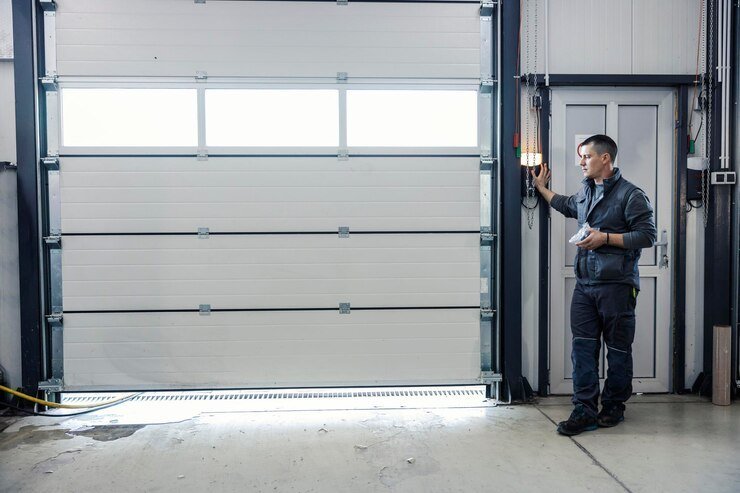Garage doors are a vital part of most homes, providing convenience, security, and protection for vehicles and belongings. However, they can also present significant safety hazards if not properly maintained or used with care. Each year, thousands of injuries occur due to malfunctioning garage doors, improper operation, or overlooked maintenance. These hazards can impact not only the homeowner but also family members, pets, and visitors. We will explore practical ways to recognize and avoid these dangers, ensuring your garage door operates smoothly while reducing the risk of accidents.
Practical Steps to Prevent Garage Door Safety Risks
- Regularly Inspect and Maintain Door Components
A garage door consists of multiple moving parts, including springs, cables, rollers, and tracks, which endure significant wear and tear over time. Regular inspections help identify early signs of damage or misalignment before they turn into serious hazards. For instance, frayed cables can snap under tension, causing the door to drop suddenly, while worn-out springs can fail unexpectedly. You should check for unusual noises, slow response times, or jerky movements, as these can indicate mechanical issues.
Lubricating the rollers and hinges also helps reduce friction and prevents strain on the system. While certain maintenance tasks can be handled by homeowners, more complex repairs—such as replacing springs—should be left to trained technicians, like those at Titan Garage Doors, as these parts are under high tension and can cause injury if handled incorrectly. Consistent care not only extends the life of your door but also keeps it operating safely.
- Test Safety Sensors and Auto-Reverse Features
Modern garage doors come equipped with safety features like photo-eye sensors and auto-reverse mechanisms, designed to prevent the door from closing if something is in its path. However, these systems can malfunction over time due to dirt buildup, misalignment, or wiring issues. To test the auto-reverse function, place an object—such as a sturdy wooden block—in the door’s path and attempt to close it. The door should reverse immediately upon contact. Similarly, photo-eye sensors, located near the base of the door, should detect movement and stop the door from closing.
Cleaning the sensors regularly and ensuring they are aligned correctly can prevent unnecessary accidents. Ignoring these features can result in severe injuries, especially to children and pets who may be in the wrong place at the wrong time. A simple monthly check ensures these mechanisms remain reliable and functional.
- Keep Hands, Feet, and Objects Away from Moving Parts
One of the simplest yet most overlooked safety rules is avoiding direct contact with the moving parts of a garage door. Children, in particular, may be curious about the door’s mechanisms, leading them to place their fingers between panels or near hinges. This can cause severe pinch injuries or fractures. Similarly, placing objects too close to the tracks or under the door can cause it to jam or derail, creating additional hazards. Educating family members on the risks and clearly designating a safe zone around the garage door can significantly reduce the chance of injury. If you store items in your garage, ensure they are kept away from the operational area to avoid accidental interference with the door’s movement. This simple awareness step plays a crucial role in preventing both mechanical damage and personal injury.
- Avoid DIY Repairs on High-Tension Components
While many homeowners enjoy tackling small repairs themselves, garage door systems contain certain parts—like torsion springs and cables—that should never be handled without the proper training and tools. These components store immense amounts of energy and can cause severe harm if released suddenly. A broken spring, for example, can whip out with enough force to cause serious injury or even damage property. Attempting to replace or adjust these high-tension parts without professional knowledge not only puts your safety at risk but can also lead to costly mistakes that worsen the problem. Instead, focus on basic maintenance tasks such as cleaning, lubrication, and sensor testing, while leaving the complex repairs to those equipped to handle them safely. Recognizing which tasks require professional intervention is a key part of keeping your garage door safe and reliable.
- Stay Alert During Operation
Operating a garage door may seem routine, but it’s important to remain alert whenever the door is in motion. Many accidents happen when someone attempts to run under a closing door, misjudging the timing or assuming the safety sensors will always work. These assumptions can lead to injury if the door closes faster than expected or if the safety mechanisms fail. Children should be taught never to play with the remote controls or wall switches, and all controls should be placed out of their reach. Additionally, avoid leaving the door partially open for extended periods, as it could slide down unexpectedly. By paying close attention to the door’s operation each time you use it, you can quickly spot irregularities and prevent accidents before they occur. Staying vigilant turns a daily habit into an important safety practice.
Garage door safety involves more than simply pressing a button—it requires consistent awareness, preventive maintenance, and responsible use. By regularly inspecting components, testing safety features, keeping clear of moving parts, avoiding dangerous DIY repairs, staying alert during operation, securing remote access, and addressing seasonal strain, you can greatly reduce the risk of accidents and malfunctions. Treating your garage door as a piece of heavy, moving machinery—rather than just another household fixture—helps ensure it serves your home effectively while keeping everyone safe.

